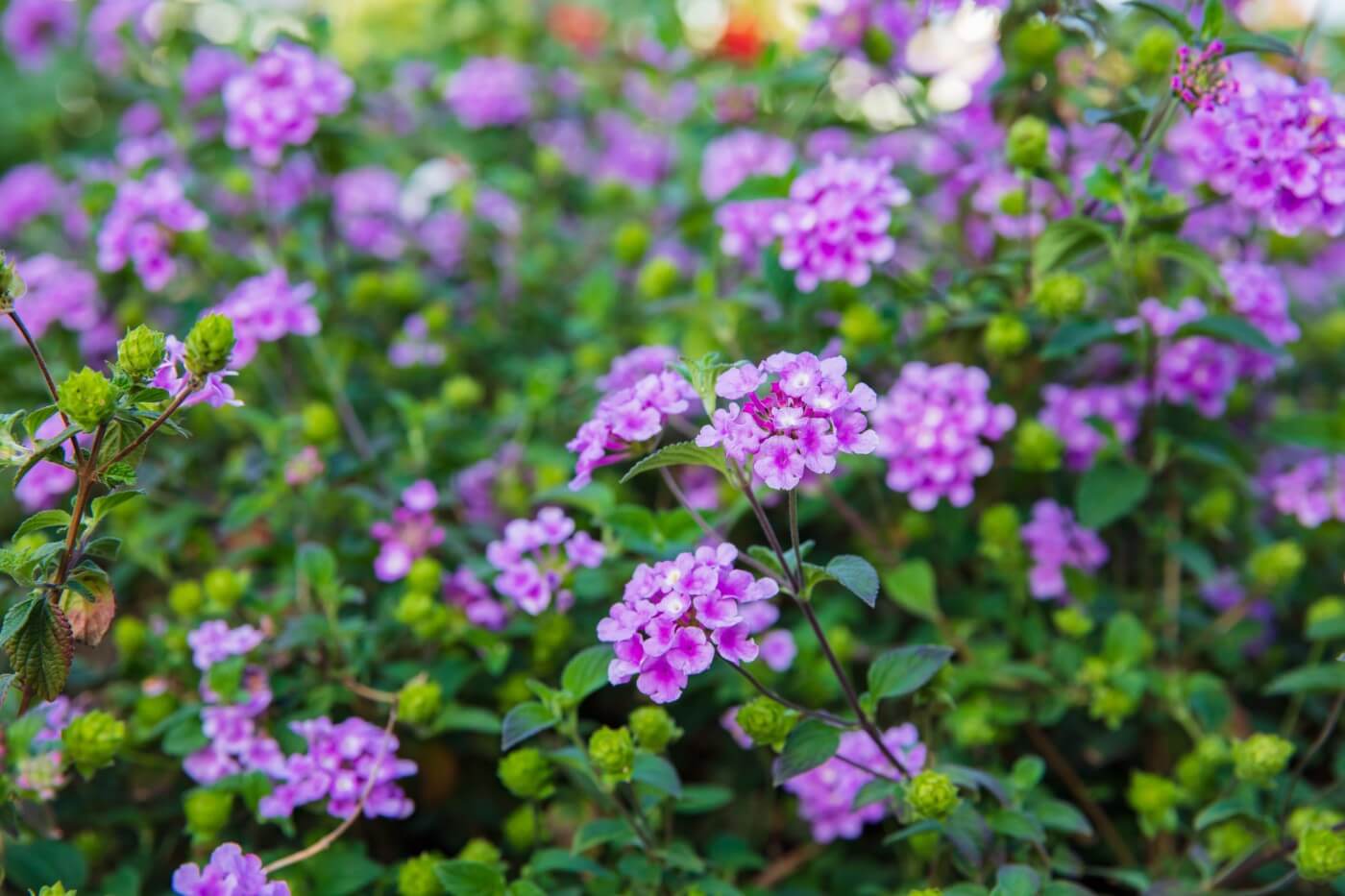Trailing Lantana: How to Plant, Grow, and Care for Beautiful Flowers
If you’re looking for a flowering ground cover or creeping plant for your garden, trailing lantana (Lantana montevidensis) might be the plant for you. This low-growing shrub sprawls over landscapes while cascading over walls and climbing fences. It brings color to the garden with many clusters of tiny flowers that bloom from spring through frost. Here, I’ll take you through everything you need to know about growing and caring for Trailing Lantana, including planting, soil considerations, light preferences, feeding, pruning, and over-winter care.

Trailing Lantana Plant Care Basics:
| Botanical Name: | Lantana montevidensis |
| Also Known As: | Trailing lantana, weeping lantana, creeping lantana, small lantana, pole-cat geranium, wild verbena |
| Hardiness Zones: | USDA zones 8-12 |
| Flowering Months: | April-November can flower year-round in frost-free areas |
| Growing Difficulty: | Easy |
| Type of Plant: | Trailing shrub |
| Light Requirements: | Prefers full sun, can tolerate some shade |
| Temp & Humidity: | Prefers temperatures between 65-90ºF and moderate humidity. Can survive temperatures down to 32ºF. |
| Watering Needs: | Water deeply once a week in the summer; this plant is drought-tolerant and can handle dry periods |
| Soil Preferences: | Well-drained |
| Feeding: | Apply a flowering fertilize once a month during the spring and summer |
| Growth Expectations: | Up to 18 inches tall and 10 feet wide |
| Toxicity: | Leaves, stems, and fruits are toxic to pets and humans |
How to Grow Trailing Lantana

What are the Best Locations?
Trailing lantana works excellent in various locations as long as it receives enough sun.
These plants thrive in spaces where other plants fail. Try planting them in bare areas that need to be covered or alongside walls they can trail down.
Trailing lantana is also great for covering eyesores like utility boxes and wells.
Since these plants can withstand high sun and drought, they can be planted up against buildings that create hot microclimates.
What are the Best Times of Year to Plant
In areas that receive frost, you should plant in spring after the danger of frost has passed.
It’s best to plant in the spring or fall if you live in a frost-free area.
Growing From Seed vs. Transplants
You may grow trailing lantana from both seed and transplants.
Transplants are typically preferred since they allow you to start with larger plants. Additionally, several types of trailing lantana are patented varieties only available in transplant form.
If you choose to grow from transplants, wait until the last frost has passed before planting outdoors.
If you want to grow from seed, it’s best to start seeds indoors—plant seeds in potting soil six to eight weeks before the last predicted frost.
Place the seedling trays somewhere warm until the seeds germinate. After seedlings emerge, you must provide bright light for ten to twelve hours daily. Therefore, place the seedlings near a sunny window or use a grow light.
Once the danger of frost has passed, you can transplant the seedlings outdoors.
What to Do Before Planting
Before you plant, check the soil. You’ll need to do some work if it appears wet or compacted.
Loosen compacted soils by digging up 6-8 inches with a shovel or digging fork. After digging up the soil, mix in some compost to improve aeration, then add the soil back into the hole.
Don’t forget that these plants will spread quite a bit. Ensure they have enough room to grow without choking out other plants.
What’s the Best Soil?
Trailing lantana needs well-drained soil. Sandy or loamy soil is ideal, but well-drained clay soil works well.
Plants don’t like constantly moist soil, so you should avoid wet areas.
Trailing lantana isn’t too particular about soil pH; a pH between 6.0 and 8.0 is suitable.
How to Plant
Planting is easy after you’ve found a suitable location and amended the soil.
Place a transplant’s root ball in the ground and cover it with soil—water well.
Light Preferences
Trailing lantana thrives in full sun. Plant them in an area that receives at least six hours of bright light each day.
These plants can tolerate a few hours of shade each day. However, more sun will lead them to produce more flowers.
Temperature & Humidity Preferences
Trailing lantana plants like it hot, or at least warm. They thrive in temperatures between 60-90ºF.
They are sensitive to cold and will die in hard frosts. If plants receive a light frost, their sensitive foliage will likely die. However, the root system may survive and produce new vegetation in the spring.
As far as humidity goes, trailing lantana isn’t too particular. Plants may develop fungal issues if humidity remains high for an extended period.
How to Care for Trailing Lantana

Watering
Although trailing lantana plants can handle drought, you’ll need to regularly water young plants until they grow a robust root system.
When plants are young, water about once or twice a week if you don’t receive any rain.
As plants mature, you’ll only need to water them every one to two weeks.
Fertilizing
Trailing lantana isn’t a heavy feeder and doesn’t require much fertilizer. Fertilizing too much can cause brittle plants and a lack of flowers.
It’s best to use a fertilizer that is designed for flowering plants. This will contain more phosphorus and potassium than nitrogen to encourage flowering.
Dilute the fertilizer to half the recommended strength and apply once a month in spring through early fall.
Pruning & Cutting Back
You don’t need to prune trailing lantana, but you can if you want to maintain a certain shape.
If your plants are getting out of control, you can trim the ends of the stems using a sharp pair of pruning shears.
Propagating
The best way to propagate trailing lantana is by stem cuttings. It’s best to take cuttings when plants actively grow in the spring and summer.
- Use a sharp and sanitized pair of pruning shears to take a stem cutting. The goal is to obtain six to eight inches of the end of a stem.
- Remove any leaves on the bottom four inches of the stem.
- Dip the end of the stem in a rooting hormone. This optional step increases the odds of successful rooting.
- Place the cutting in a glass of clean water. Only the bottom few inches should be submerged, and no leaves should touch the water.
- Place the cutting in an area that receives bright yet indirect sun. Change the water every other day.
- After a week or two, you should see roots. Once they are half an inch long, you can plant the cutting outdoors.
Overwintering
Trailing lantana is not frost hardy. If temperatures dip below 32ºF, plants will likely die.
If you live in an area that only receives a few light frosts, there is a chance your plants will survive. Even if the foliage dies, the roots may live to produce new growth in the spring.
In cold areas, gardeners often treat trailing lantana as an annual. However, you can attempt to overwinter it indoors.
A few weeks before the expected first frost, trim your plant back so the stems are four to six inches long. Next, dig up the plant’s root ball.
Place the root ball in a large container and move it indoors. You want to keep the plant somewhere that is cool and bright; a bright garage or cool room works well.
Once the threat of frost has passed, you can replant your plant outdoors.
Repotting Plants Grown in Containers
If you are growing trailing lantana in a pot, it’s best to repot every year. This plant grows rapidly and can quickly outgrow containers.
When you repot, choose a larger container and use fresh potting soil.
Deadheading
While deadheading lantana flowers will likely lead to more blooms, it isn’t necessary. Since trailing lantana has so many flowers, deadheading can become quite tedious and time-consuming.
Even if you don’t deadhead old flowers, your plants will produce many blooms.
Common Problems

Fortunately, trailing lantana doesn’t deal with too many serious problems with common garden pests. However, you should keep an eye out for the following.
Powdery Mildew
If you walk outside to find your plants coated in a white substance, chances are good they have been infected with powdery mildew. This group of fungi typically isn’t fatal, but they can stunt plant growth.
Powdery mildew is most common in damp, dark, poorly ventilated areas. Therefore, providing trailing lantana plans with enough sun and airflow is important.
Root Rot
Another issue to watch out for is root rot. A group of fungi also causes this problem.
When plants are infected with root rot, their roots cannot properly absorb water and nutrients. Therefore, you may notice yellowing or wilting leaves.
Root rot typically occurs when plants receive too much water. Remember that trailing lantana is a drought-tolerant plant that only needs to be watered every one to two weeks.
Essential Tools

The only tools you’ll need to care for trailing lantana is a pair of sharp pruning shears.
Wrapping Up
If you’re looking for a low-maintenance flowering ground cover, trailing lantana is a great choice. While it’s not cold hardy, it will survive heat and drought while empty areas with color.
Briana holds a B.S. in Plant Sciences from Penn State University. She manages a small market garden where she grows vegetables and herbs. She also enjoys growing flowers and houseplants at home.

